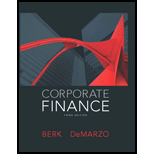
Corporate Finance
3rd Edition
ISBN: 9780132992473
Author: Jonathan Berk, Peter DeMarzo
Publisher: Prentice Hall
expand_more
expand_more
format_list_bulleted
Concept explainers
Textbook Question
Chapter 6, Problem 4P
Suppose the current zero-coupon yield curve for risk-free bonds is as follows:

- a. What is the price per $100 face value of a two-year, zero-coupon, risk-free bond?
- b. What is the price per $100 face value of a four-year, zero-coupon, risk-free bond?
- c. What is the risk-free interest rate for a five-year maturity?
Expert Solution & Answer
Want to see the full answer?
Check out a sample textbook solution
Students have asked these similar questions
Don't use ai given answer with financial accounting question
Solve with explanation and financial accounting question
15. Unearned Revenue is classified as a:A. RevenueB. AssetC. LiabilityD. Contra Revenue
Chapter 6 Solutions
Corporate Finance
Ch. 6.1 - What is the relationship between a bonds price and...Ch. 6.1 - The risk-free interest rate for a maturity of...Ch. 6.2 - If a bonds yield to maturity does not change, how...Ch. 6.2 - Prob. 2CCCh. 6.2 - How does a bonds coupon rate affect its...Ch. 6.3 - How do you calculate the price of a coupon bond...Ch. 6.3 - How do you calculate the price of a coupon bond...Ch. 6.3 - Explain why two coupon bonds with the same...Ch. 6.4 - There are two reasons the yield of a defaultable...Ch. 6.4 - What is a bond rating?
Ch. 6.5 - Why do sovereign debt yields differ across...Ch. 6.5 - What options does a country have if it decides it...Ch. 6 - A 30-year bond with a face value of 1000 has a...Ch. 6 - Assume that a bond will make payments every six...Ch. 6 - The following table summarizes prices of various...Ch. 6 - Suppose the current zero-coupon yield curve for...Ch. 6 - Prob. 5PCh. 6 - Prob. 6PCh. 6 - Suppose a five-year, 1000 bond with annual coupons...Ch. 6 - Prob. 8PCh. 6 - Explain why the yield of a bond that trades at a...Ch. 6 - Prob. 10PCh. 6 - Prob. 11PCh. 6 - Consider the following bonds: Bond Coupon Rate...Ch. 6 - Prob. 14PCh. 6 - Prob. 17PCh. 6 - Prob. 18PCh. 6 - Prob. 19PCh. 6 - Prob. 20PCh. 6 - Prob. 22PCh. 6 - Prob. 23PCh. 6 - Suppose you are given the following information...Ch. 6 - Prob. 26PCh. 6 - Prob. 27PCh. 6 - Prob. 28PCh. 6 - Prob. 29PCh. 6 - Prob. 30PCh. 6 - Prob. 31PCh. 6 - Prob. 32PCh. 6 - Prob. 33PCh. 6 - Prob. 34P
Knowledge Booster
Learn more about
Need a deep-dive on the concept behind this application? Look no further. Learn more about this topic, finance and related others by exploring similar questions and additional content below.Similar questions
- Get correct answer with financial accounting questionarrow_forwardDarla owes the government $1,800 in taxes this year. She earns a tax credit for childcare for $1, 500, $678 for earned income tax, and $250 for an energy-efficient home. How much will Darla owe the government for taxes this year?arrow_forwardI need help with financial accounting questionarrow_forward
- Given the solution and financial accounting questionarrow_forwardReflection on how public budgets influence community outcomes (e.g., housing, education, public safety). Identify one real city, school district, or agency where budget decisions have created inequities or made a positive impact.arrow_forward19. A company’s weighted average cost of capital (WACC) includes:A. Only equityB. Only debtC. Both equity and debtD. Only retained earnings need helparrow_forward
- A company’s weighted average cost of capital (WACC) includes:A. Only equityB. Only debtC. Both equity and debtD. Only retained earningsarrow_forwardNo AI A company’s weighted average cost of capital (WACC) includes:A. Only equityB. Only debtC. Both equity and debtD. Only retained earningsarrow_forwardA stock split usually results in:A. Higher stock priceB. Lower number of outstanding sharesC. Increased total market valueD. Lower stock price but same market capitalizationarrow_forward
- A stock split usually results in:A. Higher stock priceB. Lower number of outstanding sharesC. Increased total market valueD. Lower stock price but same market capitalization need helparrow_forwardNo AI Which of the following is not a component of working capital?A. InventoryB. Accounts PayableC. Long-term DebtD. Casharrow_forwardWhich of the following is not a component of working capital?A. InventoryB. Accounts PayableC. Long-term DebtD. Casharrow_forward
arrow_back_ios
SEE MORE QUESTIONS
arrow_forward_ios
Recommended textbooks for you
 Intermediate Financial Management (MindTap Course...FinanceISBN:9781337395083Author:Eugene F. Brigham, Phillip R. DavesPublisher:Cengage Learning
Intermediate Financial Management (MindTap Course...FinanceISBN:9781337395083Author:Eugene F. Brigham, Phillip R. DavesPublisher:Cengage Learning
 EBK CONTEMPORARY FINANCIAL MANAGEMENTFinanceISBN:9781337514835Author:MOYERPublisher:CENGAGE LEARNING - CONSIGNMENT
EBK CONTEMPORARY FINANCIAL MANAGEMENTFinanceISBN:9781337514835Author:MOYERPublisher:CENGAGE LEARNING - CONSIGNMENT- Principles of Accounting Volume 1AccountingISBN:9781947172685Author:OpenStaxPublisher:OpenStax College

Intermediate Financial Management (MindTap Course...
Finance
ISBN:9781337395083
Author:Eugene F. Brigham, Phillip R. Daves
Publisher:Cengage Learning


EBK CONTEMPORARY FINANCIAL MANAGEMENT
Finance
ISBN:9781337514835
Author:MOYER
Publisher:CENGAGE LEARNING - CONSIGNMENT

Principles of Accounting Volume 1
Accounting
ISBN:9781947172685
Author:OpenStax
Publisher:OpenStax College
The U.S. Treasury Markets Explained | Office Hours with Gary Gensler; Author: U.S. Securities and Exchange Commission;https://www.youtube.com/watch?v=uKXZSzY2ZbA;License: Standard Youtube License